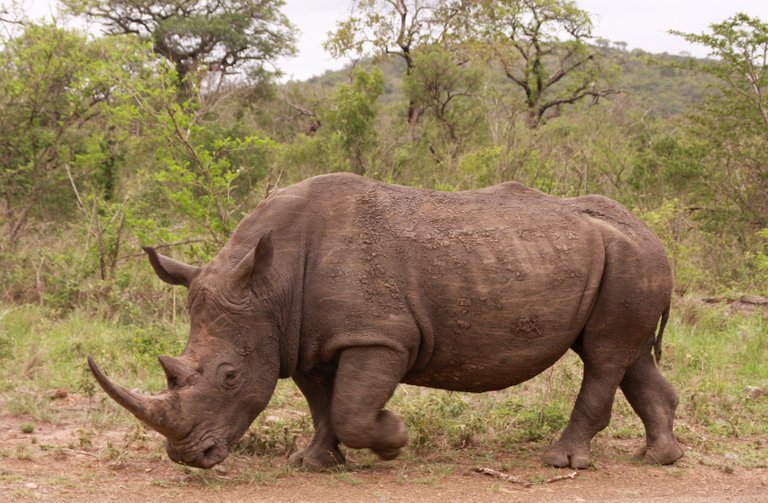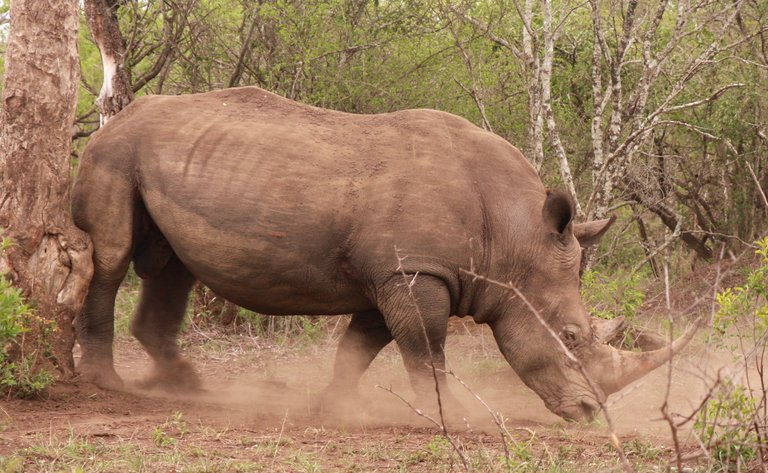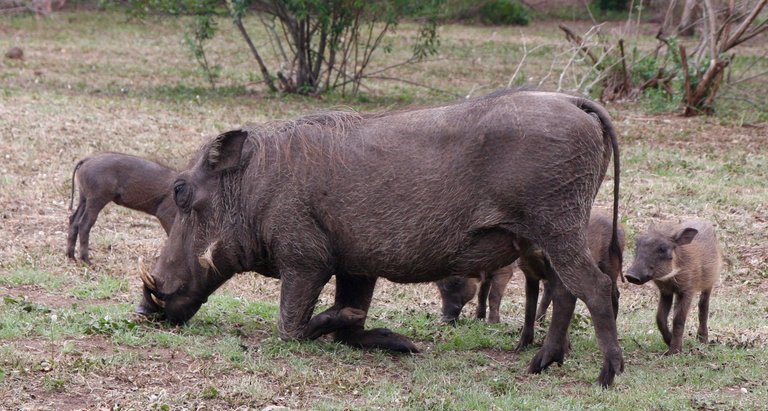Rhinos are fabulous creatures to watch, and nowhere more so than in Hluhluwe-iMfolozi. It is in this beautiful reserve in South Africa’s garden province of Kwazulu-Natal that the iconic species got pulled back from the brink of extinction.
There you see one trudging along the road, probably to a spot where it knows the grass to be sweeter, and you cannot help wondering how much the poorer this park – indeed our world – would have been without these iconic animals. It sets you wondering about the many other creatures, big and small, that we have already obliterated.

Striding to where the grass is sweeter.
You watch an enormous bull paw the earth and blow up puffs of dust with its muzzle close to the ground as it sets about marking the spot where it wants all and sundry to know it holds sway. You then wonder how it is that some people would think nothing of there and then bringing it down with a bullet to the body and hacking the horn from its head.

This is my spot.
The effort that saved the species from getting obliterated from this world happened about six decades ago when Operation Rhino was launched by renowned South African conservationist Ian Player and his fellow provincial game rangers. By then mindless hunters had with their guns already reduced the many thousands of rhinos that once roamed the vast open spaces of southern Africa to barely more than a few hundred.
Such few as remained of both the white and the vastly more endangered black rhino species were fortunate to find refuge in the Hluhluwe-iMfolozi Reserve.
The joint reserve probably had it written into its destiny to some day play this vital role. Before the two adjacent parks got linked together, the Hluhluwe portion already held the distinction of being southern Africa’s oldest reserve, having been proclaimed back in 1895 by the British administration of the then colony of Natal.
Why that portion of land, situated not far inland from the Indian Ocean coast, was so early on singled out for special protection is not difficult to see. Roads winding up its high hills offer breathtaking vistas across the undulating countryside that is cast in brilliant shades of green for all of the warmer months of the year. Down in the valleys clear streams pass through patches of forest and low bush. All over you come across animals, big and small, carrying on their lives in the wild and unknowingly offering entertainment to the many visitors passing through.

A warthog and her brood enjoy the green grass of Hluhluwe.
There was every reason for Player and his colleagues to want to keep those few rhinos as safe as they could within the boundaries of that idyllic setting. Instead they set about capturing and farming out excess animals to other parks around southern Africa and even to zoos as a way of spreading the risk and growing their numbers in different places.
South Africa’s flagship Kruger National Park, situated along the border with Mozambique, already had no rhinos left by the time of its consolidation as a single park in the early 20th Century. It is now home to about 10 000 of the more than 20 000 rhinos the species has grown to as a result of the rescue initiative set off in Hluhluwe-iMfolozi.
For all this, rhinos are once more under serious threat. All went well for the animals while China was still working towards the economic giant it is today, and while Vietnam was still suffering the impact of one of the cruelest wars of our time. The buying power since acquired by their new moneyed classes and the mistaken belief that rhino horn has healing qualities have turned out a deadly combination.
Since 2008 about 6 000 of the animals have fallen to poachers who hack off their horns for criminal syndicates to smuggle to mainly these two countries. In Kruger National Park alone more than two animals get killed every day, and this despite a massive security operation that includes soldiers, police and combat-trained rangers. Hluhluwe-iMfolozi has not been spared either.
Some poachers get killed in firefights, and many get arrested. But still they come into the park. The end price of rhino horn is $1,700 per ounce. It’s worth more than gold. So human greed is once more threatening a species that has from the mists of time managed to survive some of the worst quirks of our planet.
yes it's a great creature
great post!
Thank you so much for this post! creating awareness is the first and foremost stem to conservation!
Hello, it is actually terrible what is happening around us. In Cameroon where I live rhinos are extincted since 2006. It is great you are doing this awareness raising here on Steemit. I always like to see posts like this. If you are interested in our conservation program to save Abongphen Highland Forest in Cameroon, you could check the launching of awareness raising Conservation Champions league known as Football4Nature.
Thanks a lot. Have a nice day.